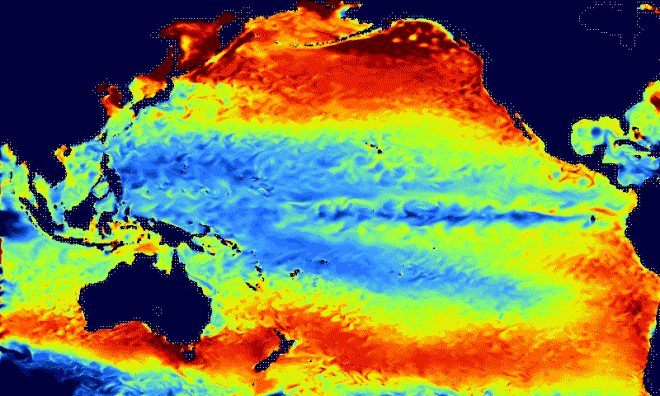Marine ecosystems are facing increasing
pressure due to
anthropogenic activities (fisheries, pollution and climate change) that
need to be managed in a holistic (ecosystem-based) and reactive way.
The management of marine resources is still based in most
cases on annual statistical stock assessment analyses ignoring the
environmental and climate variability.
There is a need for new
complementary approaches for the management and real-time monitoring of
marine resources, relying on the development of ecosystem models (e.g.,
Lehodey et al. 2008; Senina et al. 2008; Sibert et al. 2012) that can
be used in routine by the fishing authorities. |
Acoustic
Profile and micronecton sampling (Credit: Dr Jock Young, CSIRO)
|

Surface micronecton biomass
prediction |
The
predictions of the
physical-biogeochemical oceanic environment are the basic inputs needed
to develop ecosystem models of higher biological levels including
exploited species. P
rogresses of the last two decades make possible
such realistic simulations of ocean physic and the modeling of lower
trophic levels, i.e., the phytoplankton and zooplankton, is also
rapidly progressing (Brasseur et al. 2010). However, a key explanatory
variable is usually missing to understand individual behaviour and
population dynamics of large oceanic predators. This is the modelling
and prediction of the spatial distribution of micronekton. |
Micronecton
organisms are indeed both the prey of large ocean predators, but are
themselves also predators of eggs and larvae of many species from which
most fishes. Providing real-time distributions of micronecton would
pave the way for a new approach of monitoring large ocean predators
that are either targeted by fisheries (tuna , swordfish, marlin, etc.)
or strictly controlled in by-catch (bluefin tuna, sharks), or
fully protected (marine turtles, seabirds, marine mammals) as
illustrated here.
Succeeding in simulating preys (micronecton) is the key for predicting
large predators behavior
|
Movements of 3 elephant seals
(black) and micronecton biomass
around the Kerguelen Islands (Credit: Dr Cedric
Cotté, MNHN)
|
An original
modeling approach of micronekton has been proposed recently (Lehodey et
al., 2010a).
The key input parameters needed as input to this model are the 3-D
ocean currents and temperature together with net primary production and
euphotic layer depth.
All of them can be obtained directly or indirectly from space
oceanography: infrared/microwave radiometry for the surface temperature
and salinity, altimetry and space gravity measurements for the surface
currents, ocean colour for the net primary production and euphotic
layer depth.
Regarding the ocean temperature, salinity and currents, more
sophisticated approaches are needed that enable to project the surface
information measured from space into depth. These methods require the
a-priori knowledge of the ocean state covariances. A common approach is
to use historical in-situ datasets of the ocean state at depth
coincident with surface space information to compute statistical
functions.
|
Fin
whales movements and
micronecton biomass in the
Mediterranean Sea
|
| In
this project, we will demonstrate how the synergetic use of space
observations from many different Earth Observation satellites (CRYOSAT,
GOCE, SMOS, ENVISAT, together with other non-ESA
satellites) and in-situ data can
provide the key input variables for an accurate estimation of
the micronecton distribution. |